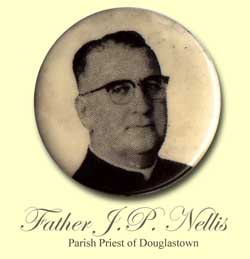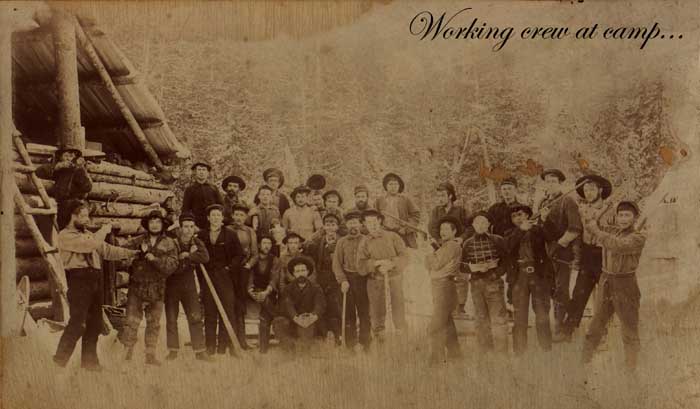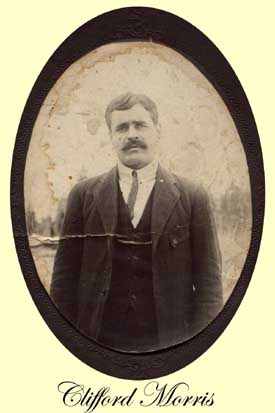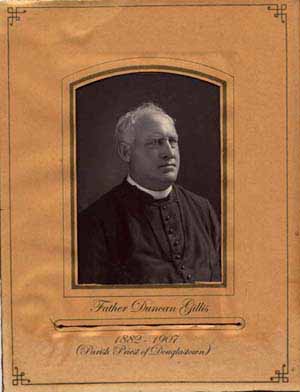|
- Mrs. Briand remembers...
- Claimed to have a photo
of the 2nd to last church.
- The sisters in Douglastown at the time were described as "nice", with
one favorite by the name of Mother St. Julia. According to Mrs. Briand,
the sisters didn't assist the priest in the church or have any related
duties, just teaching in the schools.
- Masses were held in the church largely just once per week, taking place
Sunday mornings at 10 a.m., however, a prayer session referred to as "vespers"
was held at three o'clock in the afternoon.
- People were viewed as more churchgoing then, the weekly mass being quite
the social affair, a get together, a walk. And walk they did, both winter
and summer.
|
- Although during
Father Nellis's time as Priest in Douglastown, there was a snowmobile
transportation service to mass and back, at a cost of approximately
fifty cents return, for two passengers. The time is roughly 1940,
and going to church is a rule to live by, come hell or high water.
- In that era kneeling
for communion was expected; general confession was a term unknown;
and clothes such as slacks on women or short sleeves, or any sort
of informality, was strictly prohibited inside the church itself.
- Mrs. Briand states that the rapidly decreasing formality in the
practices and opinions of the church is for the better, a definite
step ahead.
|
 |
-The annual parish visit is
described as having required a lot of preparation.
- Special dress, dinner; money donations were expected; the priests were
driven around the parish by the parishioners themselves, though supposedly
paid.
-The sacrement of First Communion was proceeded by six weeks of thorough
catechism teachings, at age ten - eleven.
- According to Mrs. Briand, in that time there were a lot of self-made
men; lacking a basic educational foundation, they managed to obtain decent
positions in firms of goood standing in cities away from the parish, such
as civil engineer.
- Family curfews were strict, as parties were attended with either one
or both parents. Ssquare dancing, fiddling, etc. were involved; a few
names from Douglastown's musical past are Mr. Willie Grant, Mr. Joe Drody,
Charlie Drody
- Those Drody's were a family of talented musicians and entertainers,
having a "Drody concert"; involved were Anthony, Joe, Mary Ellen and Bridget
Drody.
- Mrs. Briand's father's main itinerary was fishing in the summer months,
and by winter harvesting wood.
- Their family basically provided for themselves, as was largely done
then - by fishing, hunting, farming, dairying, and keeping meat animals
such as cattle and pigs. Some items, such as cream, eggs, milk, were sold
or marketed if a surplus occured, but that was rare.
- The women did such "manly" chores as work on the fields, milk the cows,
and so on.
- Yes, Women were even allowed to vote! The age limit was 21 years of
age for all voters.
- Her brother and her husband worked on the railroad in Douglastown; the
latter for forty years, retiring at age sixty-four. His position as a
foreman - sectionman required long hours and awarded little pay. For about
2$ per hour, one was expected to endure storms, and often 2 days / 1 night
shifts.
- She recalls a time when the rail service to Montreal changed and stopped
over in New Carlisle, leaving Douglastown in the afternoon.
- Her parents received a 17$ a month pension from the government, commencing
at age seventy.
|
- Miss Claribel Kennedy
recounts:
- The historical event of the coming to Douglastown of the United
Empire Loyalists, who were among the first settlers of the town.
- The seasonal work calendar for those able and willing Douglastowners
was fishing all summer off the island of Anticosti, returning in
the fall usually to harvest the forest's bounty. The townsfolk also
profited from the Anticosti through the wrechkage of the ships destroyed
on its rocks.
- A great passtime then was combing the beaches after a shipwreck,
searching for any items worth salvaging. The people knew of the
wrecks through the town's telegraph equipment. The voyages were
largely from France to Québec. The subject even heard tell of Pirates
working the Gaspé Coast, mostly around Barachois area, in the early
1800's, looting silver, china, precious gems, metals, etc.
- The vessels back then were powered by sail and by oar, and directed
by the use of a compass, and through close study of stars or other
stellar formations.
|
 |
- Churchlife was considered
too harsh and rigid, masses and sermons being long and wearisome, aften
requiring the practice of fasting for the reception of communion. Apparently,
only in the past fifgteen years has communion been received in the high
Mass.
- Miss. Kennedy describes
the people as generally less involved in the church and religion then,
perhaps due to the restrictions placed upon the people by that institution,
for example, worshippers weren't even allowed inside the Sanctuary.
- The yound people of today are reported as being a lot better; being
more open, not sneaking around but doing as they like in earnest, and
sticking up for one another.
- The subject even goes so far as to describe the people of that era as;
"...good Catholics, but not good Christians." She relates that people
were made to go to church, that they were afraid not to go; the Priests
pressed the parents for regular attendance, and the parents pressed their
families.
- It was even disallowed to attend church bareheaded.
- The first school is remembered as being log, with a schoolmaster complete
with his birch rod. Classes were mixed, with a slate and slate pencils
as recording materials.
- Math, or Arithmetic was not stressed upon heavily in the curriculum,
but Catechism, Bible History, Canadian History, Grammer and English Literature
was dwelt on.
- Longish rectangular desks seating three to four students were in use
then, needless to ssay allowing for consideraable student interaction
and mischief - making.
- Heating the classroom was a task for the males present, keeping filled
with wood the round pot-belllied stove occupying the room's center.
- Instead of direct communication with the instructress, a type of sign
language was practiced to ask for certain permission; for example, holding
up one finger might mean; May I please use the bathroom?
- The sisters as teachers are described as "kind and understanding", but
disciplining. Some of their formulated punishments were being banished
to the chapel as an isolation penalty or kneeling in front of the nun'
desk at the head of the classroom, also staying after school or the leather
streap method.
- Generally, most automatically performed jobs these days were done manually,
by hand, then. By the same token, ones wardrobe was stitched and sewn
by hand, without the use of modern-day sewing machines; all clothes, complete
with linings, petticoats, and lace.
- Sheep had to be sheared, the wool washed, dried, cleaned, carded, and
spun before finally being hand-knit into clothes that could be expected
to last a lifetime.
 |
- When a special occasion
or holiday, like Christmas, did come around, it was celebrated and enjoyed
thoroughly.
- Stockings were literally hung by the chimney with ultimate care, on
the mantle piece, in waiting for Santa Claus, who was fervently believed
in. The little children believed Santa to arrive at the window before
bringing the presents, leaving if anyone saw him; therefore, the youngsters
were terrified at the thought of accidentally catching Santa peering through
the window panes on Christmas Eve and losing all chance of receiving gifts;
Needless to say, a house's window view was strictly avoided that night.
- Another Santa Claus tradition was the father of the household, dressed
as Santa, to appear at a window and ask the children what each wanted
for Christmas gifts.
- Some typical figts were dolls, handmade wooden toys, knit clothes; hats,
mitts, oranges, apples.
- Midnight Mass was largely attended, described as being beautiful, and
a grand and welcome change from regular ten a.m. mass.
- An extensive family feast was laid out at home after the mass; all the
marvelous, mouthwatering smells and aromas of festive treats; roast beef,
vegetables, hot fresh-baked breads, cakes, cookies, puddings.
- There were no funeral parlors then - the bodies of the deceased were
waked in the house, what few preparations required for preservatioin of
the corpse were effected there. For three long days the body would be
laid out on high boards suspended off the floor, draped in sheets.
- All-night vigils were kept for the dead, candles kept burning throughout
the entire ordeal.
- Naturally, coffins were made usually by the family in mourning or by
those close to them; a plain, wood box.
- If the death occured in the winter months, the grave was dug just the
same, from the frozen ground, as the graveyard vaults of today were non-existant.
- While in mourning, the family would say "the beads" each hour, every
hour, on the hour, all night long, a practice the neighbours shared in.
At and around the time of a death in the parish, the church was blacked-out;
windows were covered in black curtains, etc.
- It was common for the family of the deceased to mourn for a year following
the death, dressed all in black and restricted from most enjoyment.
- Keeping Douglastowners informed
was the Family Herald rural newspaper, delivered by treain from Montréal
by subscrjiption method, being made available on a weekly basis.
- The Cambellton Graphic (another newsprint sold at the time) cost about
1$ for 2 years.
- Mail-order shopping was also popular, Eaton's catalogue outlet being
the most outstanding among those along the coast.
- Reading was described as a great passtime, the people scouring anything
and everything from Shakespeare to Seuss.
- In those times, it was not unheard of for mailing costs to be about
three cents to cover an ordinary letter, and one cent for a postcard.
- Douglastown possessed its own town council, which consisted of about
four councellors appointed by town pollling, and of course, the Mayor.
The Townhall housing this company was located where the Douglastown Community
Hall is today.
- Mr. Isaac Kennedy, Mr. Arthur Grant were known Mayors; a job that didn't
pay, and that carried a five-hundred dollar fine if the appointment as
Mayor was backed out of. Needless to say , the position was one of responsibility,
pressures and tensions.
- Provincial political party elections were held in separate buildings
for each party in the running for voting - either the liberal house or
the tory house.
- Apparently during the First World War there arrived in Douglastown Bay
a fleet of ships on their way to battle in other parts of the world, dating
about 1914. It was stated as being the 1st Contingent from out West.
- The vessels anchored themselves offshore for a week, enlisting new soldiers
while not allowing those already on board to debark. Known to have joined
the ranks then, were Andrew Kennedy, Mancer(?) Gaul, Jim Mulrooney.
- The following are a few statistics; little known or otherwise; Mr. Fred
Kennedy was the postmaster in the first post office, while a Mr. Dupuis
serviced the mail in her own house before that.
- The first train station was located over where the iron Bridge is now.
- Stores around town were owned and operated by the Kennedy Brothers -
C & X Kennedy; Charles Veit(?); a Jewish man named Mr. Hank.
- Alcohol was then, and still is, a weighty issue, the market for it then
being largely on the illegal side. For instance, there existed what was
termed as "Rum Runners", coming over from St. Jpierre et Miquelon, while
having to respect the designated ten-mile limit. What wasn't bought through
either legal or illegal means was home-brewed, using such ingredients
as molasses, hops, yeast cakes, oranges, water, and allowing it to ferment
in a crock for a week.
- Home entertainment was also popular, ranging from card parties, dancing,
to playing and listening to musical instruments. A few examples of the
musically inclines Douglastowners and their choice of instrument are;
Mr. Willie Grant - violin; Mr. Charlie Drody - violin; also the accordion,
organ, and Jew'S Harp were played. -Mr. Abraham Crotty settled the French
down on the Pointe in Douglastown, creating the term "crotty" in reference
to those French.
- There was a bus service running from Chandler to Gaspéj every day except
Sunday, from 10a.m. to 3p.m. costing about ten cents each way
- This service existed approximately forty years ago. Also, Norman McCauley
had organized a taxi outlet.
-Mr. and
Mrs. Mac Kennedy recall;
- Mr. Kennedy described the
inside of the old church as wooden with large wooden pillars to support
the ceiling.
- Mrs. Kennedy states that the church was heated by four large pot belly
stoves and that it was the responsibility of every family to deliver half
a cord of wood to the church every fall.
- Mr. Kennedy remembers the old graveyard was in much the same place as
the present one. He continued by stating that the old tombstones were
straightened and a new graveyard was constructed under the direction of
Father J.P.Nellis.
- Mrs. Kennedy recalled that the people were more involved in the church
and that the rituals of the church were stressed much more back then.
- The parish visit was a major event in the parish according to Mr. Kennedy.
The parishioners would donate such things as pork, fish, beef, or vegetables
to the parish priest who conducted this visit by horse and sleigh.
- The first school that either person remembered was located near the
present one.
- Mrs. Kennedy recalled that the grades were mixed and that punishment
was administered by the mother superior with a strap.
- Both persons stated that their parents were from Douglastown and that
they both originated from midsize families.
- Mr. Kennedy recalled that the average salary, when he began working,
was about 50$ a month and some examples of prices would be 10¢ for tobacco
and papers or 42¢ for a pack of cigarettes.
- According to Mr. Kennedy, fishing and wook cutting were the main sources
of income. Crown Lumber Company built and operated lumber camps back of
Douglastown that employed many local men at the time.
 |
- Mrs. Kennedy remarked that
families were very self-sufficient at that time. Every family had their
own cattle and grew their own vegetables as well as cut their own wood
for heating purposes. She also strongly emphasized the fact that women
helped to a large degree on the farm.
- Mr. Kennedy, who admitted that he has always been actively involved
in politics, recalled that compaigns and the voting process are organized
quite similarly today.
- He recalled three main general merchants operating in Douglastown in
the early 20th century; J.H.Morris, John Rooney, and C and X Kennedy.
- He recalled the first postmaster as being Mrs. Isaac Kennedy who used
to redistribute the mail throughout the community.
- The effect of the world wars on the community was seen through occasional
black-outs according to both.
- Mr. Kennedy remarked that there was a legend that said a German submarine
was destroyed in Gaspé Bassin during WW II.
- Mr. and
Mrs. Norman J. McAuley share;
- Mr. McAuley described the
location of the old church as where the rectory is presently.
- He stated that going to church was a rule to live by and that church
rituals have changed dramatically since the beginning of the century.
- Mrs. McAuley recalled the
annual parish visit as a major event in the parish. She continued by stating
that this visit was usually conducted during the winter and donations
such as food or firewood were expected.
- To the best of his knowledge
Mr. McAuley recalls that classes were conducted in the convent and were
taught by the sisters.
- He remembered punishments
as being harsh and vacations short.
- Both stated that their parents
were from Douglastown and Mr. McAuley remarked that his grandparents were
descendants from Ireland.
- They stressed the idea of
family unity in the early part of the century and the fact that every
member of the family had a specific role to play.
- Mr. McAuley recalled, when
he began working, that the average salary was 1$ a day and that prices
for products were relatively expensive in comparison to wages.
- He also stressed the importance
of the fishing industry in Douglastown with salmon and cod being the staple
fish.
- Mrs. McAuley recalled that
every family had their own beef and poultry as well as their own vegetables.
- Mr. McAuley recollected
that the railway began around 1910 and recalled the CNR opening the tracks
in the winter with V plows.
- The earliest stores that
either could remember were C and X Kennedy and Dan Beaudin which were
both located in the main village.
- The construction of the
wharf, according to Mr. McAuley, began between the years 1910 and 1915
and a local man,
David Kennedy, was foreman of the project.
(Link to a letter adressed to David Kennedy...)
- Slightly later the CNR constructed
the railway bridge connecting Douglastown and Gaspé by rail.
- According to Mrs. McAuley
(née Dorothy Morris), electricity did not reach Douglastown until the
1930's when it began to expand rapidly.
- Mrs.
Ann and Eva Holland recall;
- The old church is reported
as being located above Bernard Rooney's residence of today, and as being
heated by wood stoves, and the interior as being encircled by side galleries
near the ceiling in case of large congregations.
- The new graveyard, or the
extension of the old one, is stated as beginning in Father Nellis's era
in Douglastown parish, perhaps twenty years ago. (interviews held in 1981)
- The sisters of Douglastown
reportedly first came from Rimouski, perhaps 80 years ago. They resided
in the old convent, keeping their own farm and livestock.
 |
From left to right:
Sister of Mercy, Sister Mary of St.Mechtilde, Sister Mary of Lourdes,
Sister Mary of Calvary, Sister Mary of St.Julia |
- The old school up the Bay
in Douglastown was located around where Elias White now lives; a few notable
teachers were Mother Mary of Mercy, and Mother of the Blessed Sacrament.
They supervised the prayers in the school rooms, sacred history, which
was similar to catechism, and so on.
- For punishment, the strap
was used, isolation in the csorner, even kissing the floor - however,
for sanitary reasons was abolished. On the average, students attended
the local community school until the fourth grade, although a few priviliged
ones continued up to the ninth.
- Jobs were not plentiful,
and the fishermen having voyage to Anticosti Island for the summer months,
June to September, and in the winter working the woods, cutting logs and
the such.
- The government provided
some of the employment in the area, having the Seal Cove River bottomed
out and cleaned out by the townsfolk, paying the sum of 1$ per day, per
person.
- Steven Walsh had a store
where the CN station is now, or was until recently.
- People seemed to mingle
more then than now, at such times as the evening mail delivery. Then,
gossip was swapped over a leaf tobacco "smoke-in", ghost stories - everyone
always trying to tell one better.
- Because of the absence of
modern plumbing, people either had to carry water from the nearest brook
to the house, or pump it if there was one, and heat it on the stove top
for washing purposes.
- Hand washboards were used
for laundering, and thin, flat, cast iron irons also heated on the stovetop
for use.
- There existed very little
medical aid available for the needy, a doctor maybe at a chance being
in Gaspé - a few at the time were Dr. Pelletier, Dr. McCartney, Dr. Smily
- the latter helping in the time of the outbreak of diptheria here.
- Midwives were used in the
childbirth process, instructing the mother-to-be to brace her feet on
a chair and push. A few midwives of the time were Mrs. Emmanuel Briand's
grandmother, Mrs. Edward Maloney.
- The railroad is remembered
in the early days of its construction, around 1912.
| -
Supposedly a Mr. Fred MacDonald man was hurt or killed from a fall
off the trestle. He was hospitalized for a six-month period, however
regardless of all efforts to save his life he perished in Cartierville
hospital.
- About twenty-five
years ago the lighted cross at the crossroads in Douglastown was
installed, with the intention of blessing the parish.
- Some liquors consumed
were gin
(John DeKuyper), spirits (whiskey, white rum); some home brews were
dandelion wine
(soaked 7-8 days), beet and blueberry wine.
|

Tressel
Scene (Douglastown???) |
|

|
- After the first world
war, an epidemic of Asian flu broke out. Mr. Clifford Morris was
a noted coffin-maker of the time.
-
Approximately thirty-five years ago electricity was installed in
a large majority of the houses in the parish; thirty years ago television
was installed, using earphones and of a small screen; plumbling
also about thirty-five years ago.
- Mr. Phil Hunt had
a crank car, also Mr. Emmanuel Briand also owned one of the first
automobiles to cruise the dirt roads of Douglastown.
|
- Other
commentaries
(authors not known, but collected during the same time period as the preceeding
testimonies)
- The first graveyard in Douglastown
was located on the property which is presently owned by Bernard Rooney.
This graveyard was used up until the early 1800's when a second graveyard,
built on the property presently owned by Joseph Delaney, was completed.
This second cemetary served the expanding populatin of Douglastown up
until the mid 1800's when it was enlarged to cover its present location.
- The parish priests before
Rev. Father J.P.Nellis resided in homes around the village. Father J.P.
Nellis constructed the rectory in 1937 as a residence for future priests.
This was completed with the help of the Fabrique.
|
- Father Duncan Gillis,
hailing from Scotland and having been ordained in Paris, France,
passed away in the year 1907, to be buried underneath the previous
Douglastown church.
- There his body lay
entombed until need had it exhumed at the construction of the new
church in 1957. His remains now rest in the parish's graveyard as
it is today.
- Church masses of the
time were described as long and tiresome, the sermon alone lasting
anywhere from an hour to an hour and a half. Then, of course, there
was the confessional time alottment before the mass, communion during
the mass, collections and choir time. The ordinary, regular masses
were held weekly on Sunday mornings at 10a.m., probably lasting
until noon.

|
 |
|

